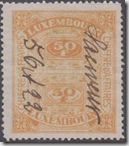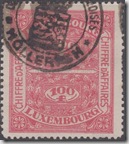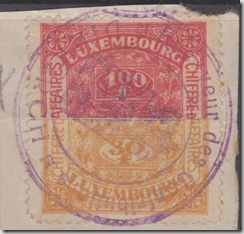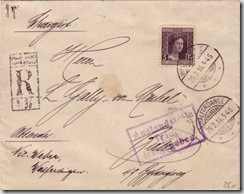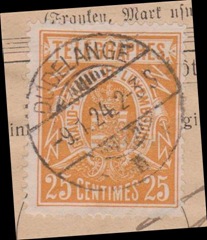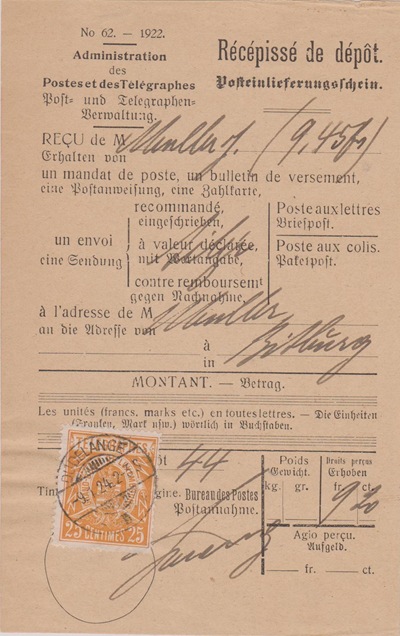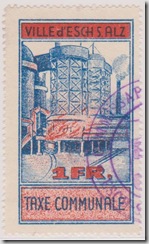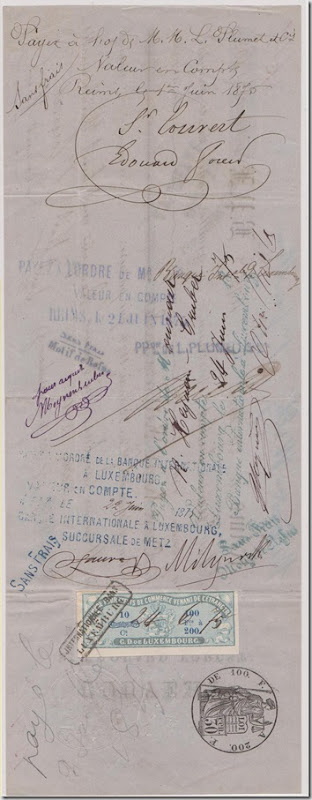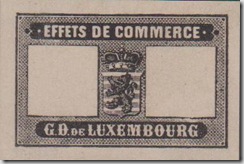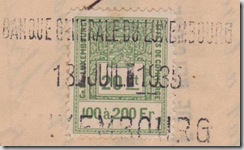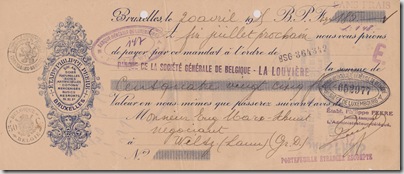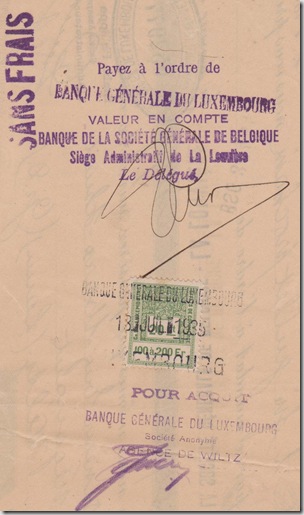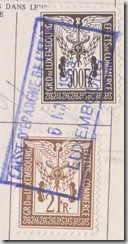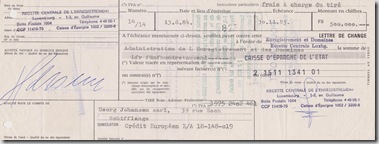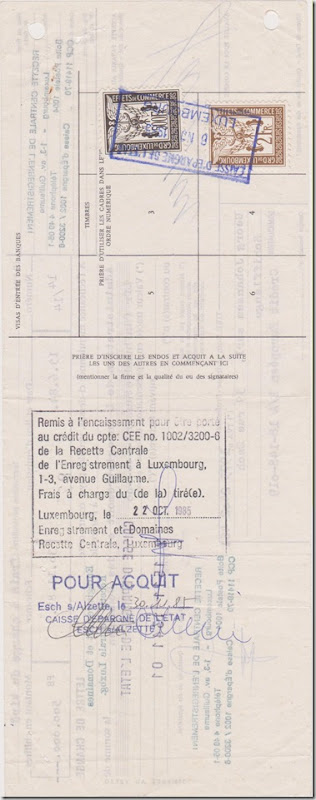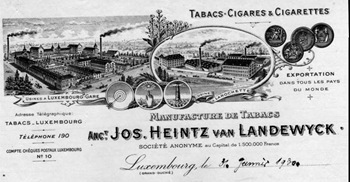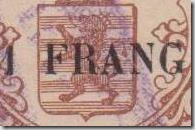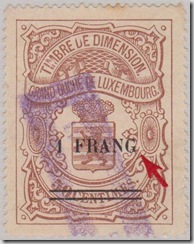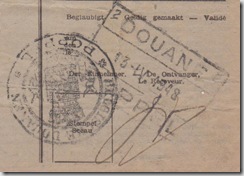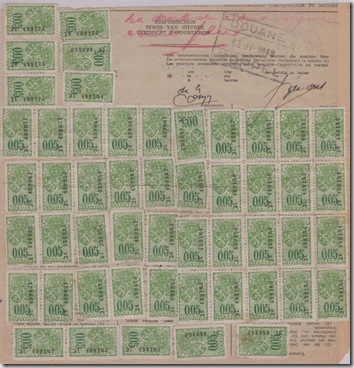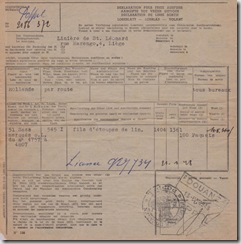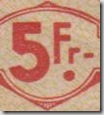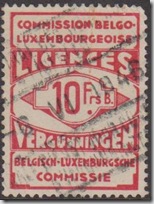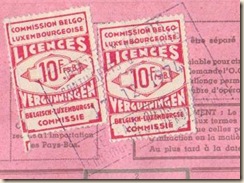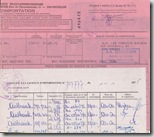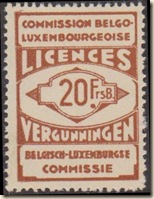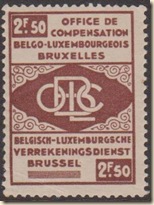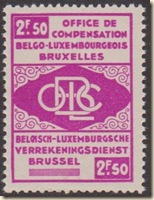1 F (4) - Berchem cds, January 5, 1924
50 F
|
100 F
|
The arrêté published in L’Memorial on September 19, 1922, proscribes the procedures for implementing the chiffre d’affaires (turnover) tax. Articles 27-30, below, provide for the design, issuance, and cancellation of the chiffre d’affaires stamps:
Art. 27. Le timbre adhésif destiné à assurer la perception de l'impôt sur le chiffre d'affaires à l'égard des commerçants en gros, du commerce d'objets de luxe et du commerce des eaux-devie ou d'alcools se compose de deux parties qui doivent être séparées avant l'emploi. Il mesure en largeur trente millimètres et, en hauteur trente-six millimètres. Il porte dans les quatres coins une rosette; sur chacun des côtés les mots «Chiffre d'Affaires » pour la partie supérieure au sommet le mot «Luxembourg» et au-dessous, au centre d'uncartouche entouré de feuilles de chêne, le montant du droit ; pour la partie inférieure à la base le mot « Luxembourg» et au-dessus, au centre d'un cartouche entouré de feuilles de chêne le montant du droit. Dans la partie supérieure le mot «Luxembourg » ainsi que le montant du droit est imprimé en blanc. Le timbre adhésif est imprimé avec fonds de sûreté, en bleu pour les taux de 10 centimes à 9 fr., en orange pour les taux de 10 fr. à 90 fr. et en rouge pour les taux de 100 fr. à 900 fr. Le fonds de sûreté est imprimé en teinte atténuée dans la couleur adoptée pour la vignette.
Art. 28. Provisoirement il est débité des timbres aux taux de 10, 20, 30, 40, 50, 60, 70, 80, 90 centimes, 1, 2, 3, 4, 5, 10, 20, 30, 50, 60, 80, 100, 200, 300 et 500 fr.
Art. 29. Les timbres adhésifs sont débités par l'administration de l'enregistrement et des domaines.
Art. 30. L'annulation du timbre complet comporte le sectionnement de la vignette par le milieu, dans le sens horizontal, de manière à laisser entière chacune des deux parties. L'annulation de chaque moitié isolée est assurée par l'indication, en chiffres arabes très apparents, de la date de l'apposition du timbre ainsi que par la signature de la personne à qui incombe l'annulation, le tout inscrit au moyen d'une encre indélébile. Toutefois, le redevable peut l'aire usage d'une griffe reproduisant à l'encre grasse son nom ou la raison sociale de sa maison ainsi que la date, en chiffres arabes très apparents, de l'apposition du timbre. La date de l'annulation doit seule être reproduite entièrement sur chacune des deux parties du timbre. Les inscriptions d'annulation ou les emgefaßten preintes de la griffe doivent dépasser le timbre d'un ou de deux côtés. Dans certains cas l'administration peut autoriser l'annulation par un timbre à date.
Article 27 specifies the three colors: blue for the range 10c to 9F; orange for 10F to 90F; and red for 100F to 900F.
Article 28 specifies 24 denominations: 10c, 20c, 30c, 40c, 50c, 60c, 70c, 80c 90c, 1F, 2F, 3F, 4F, 5F, 10F, 20F, 30F, 50F, 60F, 80F, 100F, 200F, 300F and 500F.
But Article 28 is at variance with the denominations listed in the 2007 second edition of Benelux Revenues (J. Barefoot Ltd.):
- Barefoot lists 5c and 15c denominations
- Barefoot does not list a 300 F denomination
The low (blue) denominations are fairly common. However, I’ve never seen a 5c or 15c chiffre d’affaires stamp, leading me to conclude that the 5c and 15c denominations listed by Barefoot were never issued.
The high (red) denominations are scarce. My collection only contains the 100F, but Article 28 leads me to conclude that in addition to the 200F and 500F listed by Barefoot, a 300F denomination also exists.
Barefoot indicates that the stamps were issued in “1926/1928.” However, cancelled stamps show that the stamps had appeared already in 1922.
I have not yet ascertained how the two parts were used (see the example below). Aside from the example below, my used chiffre d’affaires stamps have the two parts intact. Perhaps readers will help extract that information from the arrêté, which is accessible on the Internet at:
I have not yet ascertained how the two parts were used (see the example below). Aside from the example below, my used chiffre d’affaires stamps have the two parts intact. Perhaps readers will help extract that information from the arrêté, which is accessible on the Internet at:
Cancelled Diekirch,
Receiveur des Contributions
Receiveur des Contributions

